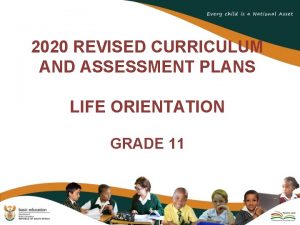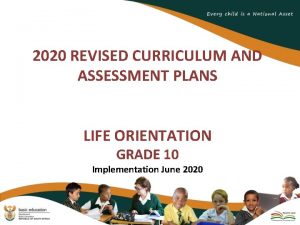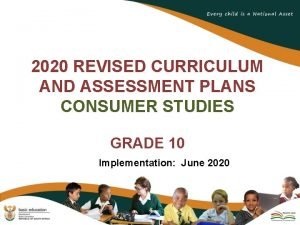2020 REVISED CURRICULUM AND ASSESSMENT PLANS CONSUMER STUDIES






















- Slides: 22

2020 REVISED CURRICULUM AND ASSESSMENT PLANS CONSUMER STUDIES GRADE 12 Implementation: June 2020

Presentation Outline 1. Purpose 2. Amendments to the Content Overview for the Phase; 3. Amendments to the Annual Teaching Plan; 4. Amendments School Based Assessment (SBA) 5. Conclusion

1. Purpose • To mediate the amendments of the trimmed and re-organised 2020 Annual Teaching Plan including School Based Assessment for Consumer. Studies, Grade 12 for implementation in June 2020 as stipulated in Circular S 2 of 2020. • To ensure that meaningful teaching proceeds during the remaining teaching time as per the revised school calendar. • To assist teachers with guided pacing and sequencing of curriculum content and assessment.

1. Purpose (continued) • To enable teachers to cover the essential core content /skills in each grade within the available time. • To assist teachers with planning for the different forms of assessment. • To ensure learners are adequately prepared for the subsequent year/s in terms of content, skills, knowledge, attitudes and values

2. Amendments to the Content Overview for the Phase

Summary: Amendments to the Content Overview for the Phase Grade 10 Grade 11 *Trimmed The Consumer Consumer needs and wants. Consumer rights and responsibilities. Decision making. Sustainable consumption. Factors influencing consumer buying behaviour. Evaluating food, clothing and furniture outlets and restaurants. Marketing strategies. The 5 P marketing mix model. The AIDA model. Grade 12 * Reorganised *No amendment The Consumer Income and expenditure of South African families. The household budget. Banking and payment methods. Consumer protection policies and practices. Consumer organisations. Channels for consumer complaints. The Consumer Financial and contractual aspects consumers should take note of. Taxes, interest rates and inflation. Sustainable consumption of water and electricity. Responsibilities of municipalities and communities.

Summary: Amendments to the Content Overview for the Phase Grade 10 Grade 11 *Trimmed Food and Nutrition Consumer needs and wants. Consumer rights and responsibilities. Decision making. Sustainable consumption. Factors influencing consumer buying behaviour. Evaluating food, clothing and furniture outlets and restaurants. Marketing strategies. The 5 P marketing mix model. The AIDA model. Grade 12 * Reorganised *No amendment Food and Nutrition Income and expenditure of South African families. The household budget. Banking and payment methods. Consumer protection policies and practices. Consumer organisations. Channels for consumer complaints. Food and Nutrition Financial and contractual aspects consumers should take note of. Taxes, interest rates and inflation. Sustainable consumption of water and electricity. Responsibilities of municipalities and communities.

Summary: Amendments to the Content Overview for the Phase Grade 10 Grade 11 *Trimmed Design elements and principles Grade 12 * Reorganised *No amendment Design elements and principles Design elements (line, shape, form, space, colour and texture). Design principles (proportion, balance, rhythm, harmony, emphasis). Colour (terminology, colour wheel, colour combinations). Application in clothing and interior finishes. Design elements and principles Application of design elements and principles when planning a wardrobe.

Summary: Amendments to the Content Overview for the Phase Grade 10 Grade 11 *Trimmed Fibres and Fabrics The origin, properties and * Reorganised *No amendment Fibres and Fabrics Appearance, properties use of fibres and fabrics in and uses of fabric clothing and furnishings: construction techniques natural fibres, regenerated for clothing and cellulose fibres, synthetic furnishings. polymer fibres, textile Fabric properties and blends. The choice of finishes for clothing and textiles for clothing and household textiles. soft furnishing. Grade 12

Summary: Amendments to the Content Overview for the Phase Grade 10 Grade 11 *Trimmed Clothing Grade 12 * Reorganised *No amendment Clothing • The young adult’s choice of suitable clothing. Fashion and appearance in the world of work. • Adaptive clothing for the disabled. The fashion cycle and current fashion trends for young adults. Planning a basic wardrobe. Consumer issues regarding clothing and textiles

Summary: Amendments to the Content Overview for the Phase Grade 10 Grade 11 *Trimmed Housing and Interior Factors influencing housing decisions. Design features in housing and interiors: ergonomics and universal design. Enabling housing environments for the disabled. Grade 12 * Reorganised *No amendment Housing and Interior Space planning. Different housing Choice of furniture. acquisition options. Evaluation criteria when Financing related to purchasing furniture. buying a house. Choice of household appliances. Finances and contracts related to buying furniture and household appliances.

3. Amendments to the Annual Teaching Plan

Summary: Reorganisation of content topics The Consumer Taxes, interest rates and inflation. Financial and contractual aspects consumers should take note of. Sustainable consumption of water Sustainable consumption of electricity

Summary: Amendment to the weighting of content topics • Weighting of content topics remain unchanged and align to the CAPS Policy for Consumer Studies

Gr 12 Summary: Content/Topics Amended Content/Topics The Consumer Taxes, interest rates and inflation Term Amendment = Reorganisation Term 3 Week 7 Term 3: Week 7 moves to Term 2 : Week 8 Term 3 The Consumer Financial and contractual aspects Week 6 consumers should take note of. Term 3: Week 6 moves to Term 4 : Week 1 The Consumer Sustainable consumption of water Sustainable consumption of electricity Term 4 Weeks Term 4: Weeks 1 and 2 are grouped into Term 4 : Week 2

4. Amendments School Based Assessment (SBA)

Summary: Revised Programme of Assessment Term 1 Term 2 March Test 50 % Term 3 Term 4 Task 5: Trial Exam 200 marks 100 % SBA Term 1+2+3 = 225 (÷ 2. 25) to convert to 100 Task 2: Project 25% Task 3: Three (3) Practical Lessons 25% 100 PAT (ONE) Task 100 Task 4: Three (3) Practical Lessons 25% 25 November Examination 200 100 400 ÷ 4 100

Summary: Revision Final NSC Examination Structure Questions Content Mark allocation 1 Short Questions (all topics) 40 2 The Consumer 20 3 Food and Nutrition 40 4 Clothing 20 5 Housing 40 6 Entrepreneurship 40 100 % compliance to the original structure in CAPS p 63 200

Summary: Revised Practical Assessment Task (PAT) • The original PAT consists of: – PAT 1 100 marks + PAT 2 100 marks • PAT: One Practical Examination (100 marks) – Weighting of marks not affected. – SKAV assessed are standardised. – The PAT is amended to manage social distancing and acceleration of time.

4. Conclusion

Conclusion SBA • A uniform, standardised approach is used across Grade 10 -12 in Consumer Studies. • No important aspect of the Grade 12 curriculum is compromised. • Re-organisation, maintains and supports the foundational principles of the National Curriculum Statement (NCS) as stated for Tourism. • The allocated time on the revised ATP is realistic to teach content/ activities and assessment and are aligned to the available time. • The ATP exposes learners to a variety of forms of assessment. • The amended School Based Assessment (SBA) aligns to the content and time available. • Informal assessment focuses on the principles of assessment for learning in the context of specific or a combinations of topics. • Informal activities prepare the learner for the formal assessment and final NSC examinations. PAT • The amendment for the Gr 12 PAT aligns to the time available. • Social distancing requirements are adhered to.

Contact Details Name: Magda van Pletzen CES: Services Subjects Department of Basic Education Tel: 0828264217 Email: vanpletzen. M@dbe. gov. za
 2020 revised curriculum and assessment plans
2020 revised curriculum and assessment plans 2020 revised curriculum and assessment plans
2020 revised curriculum and assessment plans 2021 revised curriculum and assessment plans
2021 revised curriculum and assessment plans 2020 revised curriculum and assessment plans
2020 revised curriculum and assessment plans 2020 revised curriculum and assessment plans
2020 revised curriculum and assessment plans 2020 revised curriculum and assessment plans
2020 revised curriculum and assessment plans Business studies grade 11 2020 term 2 sba task presentation
Business studies grade 11 2020 term 2 sba task presentation 2020 revised curriculum and assessment plans
2020 revised curriculum and assessment plans Revised curriculum 2020
Revised curriculum 2020 Revised curriculum 2020
Revised curriculum 2020 2020 revised curriculum and assessment plans
2020 revised curriculum and assessment plans 2021 revised curriculum and assessment plans
2021 revised curriculum and assessment plans 2020 revised curriculum and assessment plans
2020 revised curriculum and assessment plans 2020 revised curriculum and assessment plans
2020 revised curriculum and assessment plans 2020 revised curriculum and assessment plans grade 7
2020 revised curriculum and assessment plans grade 7 Revised programme of assessment 2020
Revised programme of assessment 2020 2020 revised curriculum and assessment plans grade 7
2020 revised curriculum and assessment plans grade 7 2020 revised curriculum and assessment plans
2020 revised curriculum and assessment plans 2020 revised curriculum and assessment plans grade 6
2020 revised curriculum and assessment plans grade 6 2020 revised curriculum and assessment plans grade 6
2020 revised curriculum and assessment plans grade 6 Revised curriculum 2020
Revised curriculum 2020 Grade 9 ems term 1 assignment 2020
Grade 9 ems term 1 assignment 2020 2020 revised curriculum and assessment plans
2020 revised curriculum and assessment plans





































